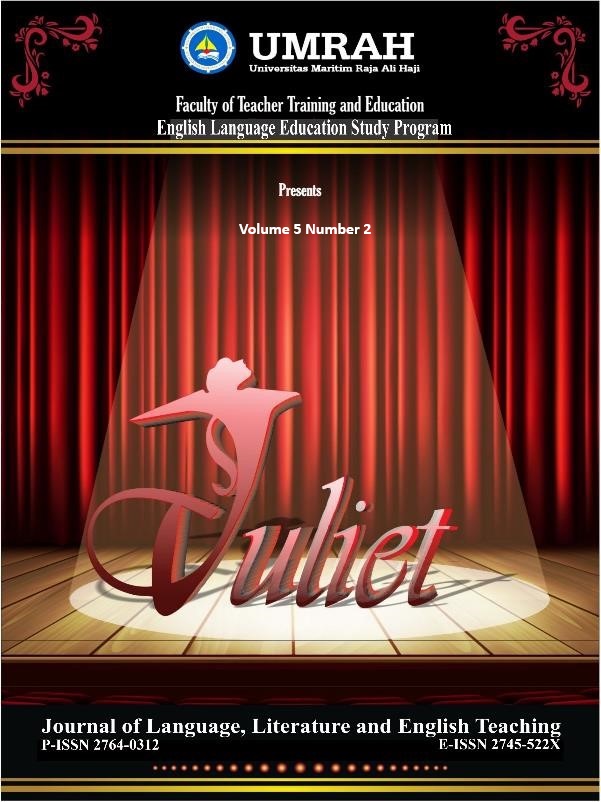Representation of Gender Found in “English for Nusantara” EFL Textbook
DOI:
https://doi.org/10.31629/juliet.v5i2.6989Keywords:
bias, english, gender, representation, textbookAbstract
This research aimed to identify gender representation found in English for Nusantara EFL textbook. This research was qualitative research. The data of this research were collected from English for Nusantara EFL textbook specifically for ninth grade. The researchers adopted a framework form Amini & Birjandi (2012) in analysing the data. The researchers focused on some aspects of gender representation such as visibility, firstness, feminine/ masculine generic construction, activity, and occupation. The finding of this research revealed that there is a gender bias between male and female in the textbook. This imbalance suggests a perpetuation of gender biases that can influence learners' perceptions and expectations regarding gender roles. Educators and curriculum developers must recognize the importance of equitable gender representation to foster an inclusive learning environment. Addressing these biases is essential for promoting gender equality and empowering all students, regardless of gender, to envision a wider range of roles and opportunities.
References
Agni, Z. A., Setyaningsih, E., & Sarosa, T. (2020). Examining Gender Representation in an Indonesian EFL Textbook. Register Journal, 13(1), 183–207. https://doi.org/10.18326/rgt.v13i1.183-207
Amini, M., & Birjandi, P. (2012). Gender Bias in the Iranian High school EFL Textbooks. English Language Teaching, 5(2), 134–147. https://doi.org/10.5539/elt.v5n2p134
Angelina, V., & Arianto, T. (2022). Representation of Family Gender Roles in “Big Little Lies” Novel By Liane Moriarty. Jurnal Basis, 9(2), 279–290. https://doi.org/10.33884/basisupb.v9i2.5557
Dharma, Y. P., & Aristo, T. J. V. (2018). An Analysis of English Textbook Relevance to the 2013 English Curriculum. Journal of English Educational Study, 1(1), 24–33.
Junita, J., T. Pasaribu, J. B. T. P., & Vidiastya, A. N. (2022). An Analysis of Gender Representation in I Love Jakarta, an Elementary Textbook. Journal of English Language and Culture, 13(1), 10–23. https://doi.org/10.30813/jelc.v13i1.3652
Muzdalifah, A., Noorman, S., & Gunawan, W. (2022). Gender Representation in English Textbook: A Visual Grammar Analyis. Jurnal Penelitian Pendidikan, 21(3), 85–95. https://doi.org/10.17509/jpp.v21i3.43093
Ndari, W., Suyatno, Sukirman, & Mahmudah, F. N. (2023). Implementation of the Merdeka Curriculum and Its Challenges. European Journal of Education and Pedagogy, 4(3), 111–116. https://doi.org/10.24018/ejedu.2023.4.3.648
Novianti, P., & Ambarwati, E. K. (2023). A Textbook Analysis of “My Next Words” for the Fifth Grade Elementary School. Jo-ELT (Journal of English Language Teaching), 10(1), 12–25. https://doi.org/10.33394/jo-elt.v10i1.6972
Rachmijati, C., & Cahyati, S. S. (2018). Gender Representation in Textbook Bahasa Inggris Grade X. Journal of English Language Teaching in Indonesia, 6(2), 59–69. https://doi.org/10.22460/eltin.v6i2.p59-69
Rohimajaya, N. A., & Hamer, W. (2022). Merdeka Curriculum for High School English Learning in the Digital Era. KLAUSA: Kajian Linguistik, Pembelajaran Bahasa, Dan Sastra, 6(2), 1–15. https://doi.org/10.33479/klausa.v6i2.625
Rohmatillah, & Pratama, D. A. (2017). An Analysis of Textbook Entitled “ Pathway to English ” Published By Erlangga at the First Semester of the 11 th Grade of Senior High School. English Education: Jurnal Tadris Bahasa Inggris, 10(2), 326–343.
Yulistiana, W., Rusmawaty, D., Suhatmady, B., & Mulawarman, U. (2022). The Representation of Gender in the Required EFL Textbook of an Indonesian Junior High. E3L: Journal of English Teaching, Linguistic, and Literature, 5(1), 1–8.
Downloads
Published
Issue
Section
License
Copyright (c) 2024 Journal of Language, Literature, and English Teaching (JULIET)

This work is licensed under a Creative Commons Attribution 4.0 International License.





